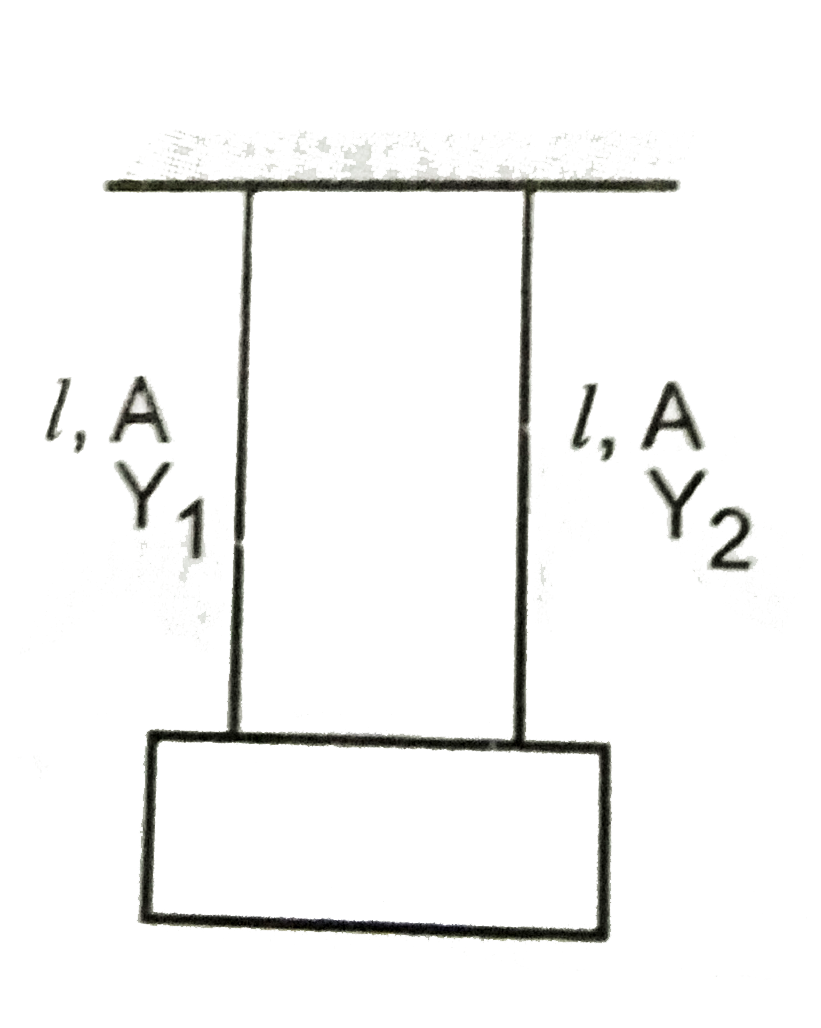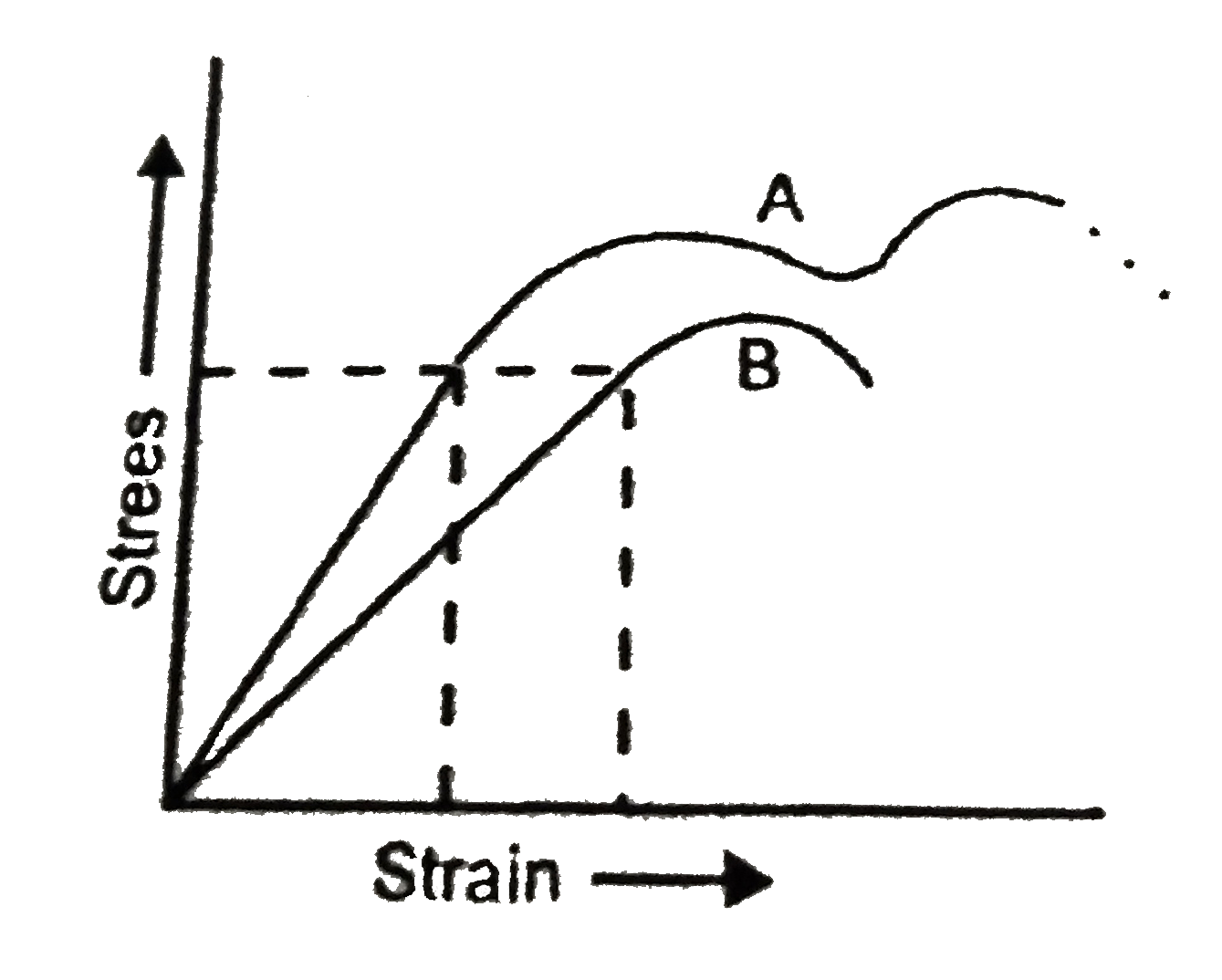Complete Solutions to Now answer the following : of chapter DAILY PRACTICE PROBLEMS of Class 11 book with complete answers and questions
| Class 11 | PHYSICS |
| Chapter | DAILY PRACTICE PROBLEMS |
| RESONANCE | Now answer the following : |
| Number Of Questions | 20 |
| Academic Year | 2023-24 |
A wire elongates by 1.0 mm when a load W is hanged from it. If this wire goes over a pulley and two weights W each are hung at the two ends the elongation of the wire will be
View SolutionThe length of a metal is `l_(1)` when the tension in it is `T_(1)` and is `l_(2)` when the tension is `T_(2)` . The natural length of the wire is
View SolutionA heavy mass is attached to a thin wire and is whirled in a vertical circle. The wire is most likely to break
View SolutionTwo wires of equal length and cross sectional area suspended as shown in

Their Young's modulii are `Y_1 = 2xx10^(11)` Pa and `Y_2 = 0.90 xx 10^(11)` Pa respectively. What will be the equivalent Young's modulus of combination?
View SolutionA steel wire and a copper wire of equal length and equal cross- sectional area are joined end to end and the combination is subjected to a tension. Find the ratio of
copper/steel
(a) the stresses developed . In the two wires,
(b) the strains developed. (Y of steel `= 2xx10^(11) N//m^(2)` Y of copper `= 1.3xx10^(11) N//m^(2)`)
View SolutionA steel rod of cross sectional area `4cm^2` and length `2m` shrinks by `0.1 cm` as the temperature decreases in night. If the rod is clamped at both ends during the day hours, find the tension developed in it during night hours. Young modulus of steel `=1.9xx10^11 Nm^-2`
View SolutionConsider the situation shown in figure. The force F is equal to the `(m_2g)/2`. If the area of cross section of the string is A and its Young modulus Y, find the strain developed in it. The string is light and there is no friction anywhere.

View SolutionIf in a wire of Young's modulus `Y`, longitudinal strain `X` is produced then the potential energy stored in its unit volume will be:
View SolutionA metal wire of length `L` is suspended vertically from a rigid support. When a bob of mass `M` is attached to the lower end of wire, the elongation of the wire is `l:`
View SolutionA metal wire of length L, area of cross-section A and young's modulus `Y` is stretched by a variable force `F` such that `F` is always slightly greater than the elastic forces of resistance in the wire. When the elongation of the wire is `l`
View SolutionTwo wires of the same material and length but diameter in the ratic 1: 2 are stretched by the same load. The ratio of elastic potential energy per unit volume for the two wires is
View SolutionThe workdone in increasing the length of a one metre long wire of cross `-` sectional area `1 m m^(2)` through `1mm` will be `(Y=2xx10^(11)Nm^(-2)) :`
View SolutionOne end of a long metallic wire of length L is tied to the ceiling. The other end is tied to massless spring of spring constant k. A mass m hangs freely from the free end of the spring . The area of cross-section and Young's modulus of the wire are A and Y respectively . If the mass is slighty pulled down and released , it will oscillate with a time period T equal to
View SolutionIn the figure shown the straing versus stress graph for two values of young's modulus ?

`(i)` which material is more ductile ? Explain.
`(ii)` Which material is more brittle ? Explain.
`(iii)` Which material is stronger ? Explain.
View SolutionA metal square plate of `10cm` side rests on `2mm` thick caster oil layer. Calculate the horizontal force needed to move the plate with speed `3cm s^(-1) : (` Coefficient of viscosity of caster oil is 15 poise. )
View SolutionA man starts rowing his stationary cuboidal boat of base area `A=10m^(2)`. The driving force on the boat due to rowing is `100N` in the direction of motion. Find the maximum velocity that the boat can achieve. Also find the time in which he will attain half of this maximum velocity. `[` Take coefficient of viscosity of water `=15` poise `]` The depth of the lake is `10m` and the combined mass of man and the boat to be `150kg. (u=0`, velocity gradient uniform)
View Solution_S01_038_Q01.png)
As per the shown figure the central solid cylinder starts with initial angular velocity `omega_(0)` Find the time after which the angular velocity becomes half.
View SolutionA ball bearing of radius of `3mm` made of iron of density `7.85g cm^(-3)` is allowed to fall through a long column of glycerine of density `1.25gcm^(-3)`. It is found to attain a terminal velocity of `2.20cms^(-1)`. Determine the viscosity of glycerine in centipoise. `(` Take `g=10m//s^(2))`
View SolutionAn air bubble of `1cm` radius is rising at a steady rate of `0.5cms^(-1)` through a liquid of density `0.81gcm^(-3)`. Calculate the coefficient of viscosity of the liquid. Neglect the density of air. `(` Take `g=10m//s^(2))`
View SolutionA metallic sphere of radius `1.0 xx 10^(-3) m` and density `1.0 xx 10^(4) kg//m^(3)` enters a tank of water, after a free fall through a distance of h in the earth's gravitational field. If its velocity remains unchanged after entering water, determine the value of `h`. Given: coefficient of viscosity of water `= 1.0 xx 10^(-3) N s//m^(2), g = 10ms^(-2)` and density of water `= 1.0 xx 10^(3) kg//m^(3)`.
View Solution
Now answer the following : questions and complete solutions for chapter DAILY PRACTICE PROBLEMS of RESONANCE ENGLISH of Class 11
All Exercises from RESONANCE Class 11 PHYSICS DAILY PRACTICE PROBLEMS
- comprehension
- Compreshension
- dpp 15
- dpp 16 physics
- dpp 17
- dpp 18
- dpp 19
- dpp 2 PHYSICS
- dpp 20
- dpp 21
- dpp 22.
- dpp 24
- dpp 25
- dpp 26
- dpp 27
- dpp 28
- dpp 30
- dpp 31
- dpp 32
- dpp 33
- dpp 34
- DPP 35
- dpp 36
- Dpp 37
- dpp 38
- dpp 39
- dpp 40
- dpp 41
- dpp 42
- dpp 43
- dpp 44
- DPP 45
- dpp 46
- dpp 47
- dpp 48
- dpp 49
- DPP 50
- dpp 51
- dpp 52
- dpp 53
- dpp 54
- DPP 55
- dpp 56
- dpp 57
- dpp 58
- dpp 59
- dpp 60
- DPP 62
- dpp 63
- dpp 64
- DPP 65
- dpp 66
- dpp 67
- dpp 68
- dpp 69
- dpp 70
- dpp 71
- dpp 72
- dpp 74
- dpp 75
- dpp 76
- DPP 77
- dpp 78
- dpp 79
- DPP 8 PHYSICS
- dpp 80
- dpp 81
- dpp 82
- dpp 83
- dpp 84
- dpp 85
- dpp 86
- dpp 87
- dpp 88
- dpp 89 illustration
- dpp 90 Illustration
- dpp 91 illustration
- dpp 92 illustration
- Dpp no 10 physics
- Dpp no 11 physics
- Dpp no 12 Physics
- Dpp no 6 physics
- DPP NO 7 PHYSICS
- DPP no 9 physics
- Dpp no. 13 physics
- DPP NO. 14 PHYSICS
- DPP NO. 5 Physics
- dpp23
- dpp29
- dpp61
- dpp73
- Now answer the following :
- PHYSICS
- TRUE/FALSE